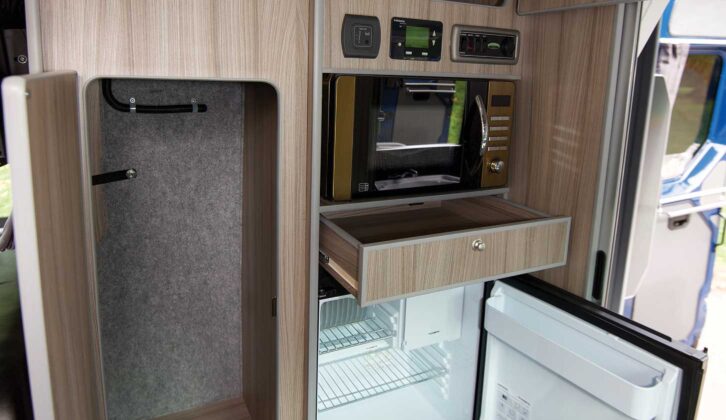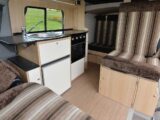We all love a bargain. Nobody likes to pay over the odds for anything and motorhomes are no exception. Ever since the various recent crises that have struck the UK – Brexit, wars, Liz Truss and Covid-19 – the economy has suffered and costs have inexorably risen. During the pandemic particularly, it was noticeable how many non-professional, self-build campervans popped up for sale at amazing prices.
From self-build campervans to one-person start-up companies, there were new conversions all over social media and the internet. And you can understand why – what better way to escape from the latest crisis than by enjoying the freedom of a leisure vehicle? The best camper vans offer comfort and a great spec for an enjoyable touring experience – but what about self-build conversions? If you’ve been considering one, we’re taking a look at the key points to consider – and the hazards to be aware of – before you take the plunge.
Another crucial step to choosing the right model for you will be picking the best van for a camper conversion – after all, each base vehicle will come with its own pros and cons too.
Self-build campervans – the points to consider
The safety question
NCC approval
The resale value
How to check a vehicle
Seatbelts for all occupants
Get a professional inspection
Checking out your purchase
Campsites and self-build campervans
Self-build campervan conversions: the pros and cons
Self-build campervans – the safety question
The concern with any vehicle built on a DIY basis, or by some inexperienced firms, is a simple one: safety.
It is quite incredible that you can fit almost any item you like into the back of a van, with no form of safety checks at all. Conversions are not subject to any MoT checks and, while you have to declare modifications to the DVLA, many people don’t.
So there are no checks and balances on the handiwork of the builder.
I don’t know about you, but to me, that is worrying. Just look around you – one of your friends will always be a DIY wizard who can build anything to the highest standard.
But it’s your other mate – the one who can’t put up a shelf without perforating a water pipe – who is the problem here. Do you really want somebody like that let loose on a motorhome conversion? Clearly not. But they’re out there and their wares are available to see all over social media.

Unfortunately, in my opinion, some – by no means all, but some – non-professional motorhome builders have a distinct tendency to overestimate their skillset, or to rely on some unqualified YouTube ‘expert’ who has good presentation skills.
But no matter how cool a self-build motorhome looks on the exterior, it’s how well it has been constructed under the skin that really matters. Have they clipped the wiring securely in place? Are their fuses fitted at appropriate places and is the motorhome’s gas system free from leaks? Did they use a subframe or spreader plates on the rear travel seat?
These are just a few examples of vital safety points that can easily be missed by inept or careless builders who are happy to cut corners.
Many self-builders are excellent and rigorously apply safety standards to their work, but because it’s far easier, quicker and cheaper to ignore some aspects of safety, you have to ask the question – are all self-builds built to a high standard? Cutting corners for convenience is nothing new.
If only there were some overseeing organisation that could monitor safety and quality standards, so you would know exactly what you were buying! Happily, there is.
NCC approval of self-build campervans
Wandering around one of the industry events such as the NEC motorhome show in October, you’ll probably have spotted the discreet blue ‘NCC’ lettering on a white badge that is often affixed near the entrance door of the vehicle.
This badge indicates that the maker is a member of the National Caravan Council, the not-for-profit trade body that overseas the leisure vehicle market and which organises the main indoor shows.
The NCC has established a set of standards for the market to attain, encompassing technical regulations – from gas lockers to motorhome water systems – that have built up over the years.

Few people realise that it has been guiding our industry since 1939, and its 850 members include manufacturers, dealerships, distributors, workshops, suppliers and even holiday parks and residential parks.
So when you see the NCC logo on a vehicle, workshop or product, you know that it has had to meet certain quality standards and that the firm is committed to making its vehicles as good as they can be.

That’s not to say that every non-NCC-member brand is inferior – there are many great, high-quality non-member makers and converters out there. But NCC membership is a reassuring confirmation that the firm takes quality standards seriously.
The resale value of self-build campervan conversions
Dealers and private buyers can easily work out the value of a conversion from one of the best campervan conversion companies UK – just Googling that model will quickly find similar ones for sale or sold, and the correct pricing of the vehicle will be simple to find. With any unique self-build ’van, it’s not so easy and the lack of precedence in pricing means they have to be valued as a one-off prototype. This value can vary dramatically and is very much in the eyes of the purchaser.
Many motorhome dealers won’t touch non-professional self-build ’vans for this reason, or will offer a very low trade-in price and immediately sell the vehicle to a trader or send it to the auctions. This is why the majority of self-builds are offered online.

Finding buyers who share the vision for self-build – rather than opting for a brand – can also make the vehicles harder to sell on, because the potential customer pool is so much smaller.
This also raises the important issue of depreciation. Often, a higher-priced vehicle works out as better value in the long run, because it depreciates less.
Branded vehicles cost more initially, but they are also worth far more when it comes to selling them on, so the overall cost of ownership can often turn out to be lower than with a much lower-priced self-build.
Some motorcaravanners will say that resale value isn’t important, because they have no plans to sell the vehicle, but this should still always be a factor in any purchasing decision.
As the ’van ages, or your lifestyle and needs change over time, you’ll inevitably have to replace it, and having as much retained value kept in it as possible is simply wise money management.
Self-build campervan insurance
Non-professional self-builds are not particularly liked by insurers and the number of specialist firms willing to offer cover isn’t large. Many firms do offer self-build cover, but are not keen on the added risk and will likely bump up the prices accordingly. This reduced choice of brokers means that you’ll pay more for the insurance, and you might not get the same level of cover that a Club insurer or a top-flight company will provide.
This is often overlooked by customers who are thinking about purchasing a non-professional self-build ’van, and it can add considerably to the annual running costs of the vehicle.
How to check self-build campervans
Let’s be realistic, people will always be tempted by bargain-priced non-professional self-build campervans that looks the part inside, with fashionably smart soft furnishings and fixtures, and lots of fancy lighting. But that eye-catching interior is no guarantee of quality, so how do you go about checking it’s safe and well built?
The place to start is underneath the vehicle. Look at the gas pipes, wiring runs and travel seat fixings. If the wiring is neatly clipped and cable-tied in place, and gas pipes are in straight runs supported by evenly spaced P-clips, that’s a good sign.
If wiring and piping under the ’van looks messy, you can bet that the rest of the vehicle will follow suit.
The presence of a gas safety certificate and a sealed gas locker (with a dropout vent in the floor) is essential; if these are missing, it tells you the seller doesn’t know about gas safety regulations, or doesn’t care. Either way, walk away.

Check the operation of every bed, folding table and cabinet door – does it all feel solid and well made?
It’s especially important to take a close look inside the cabinets and see how they are fixed in place – do they just use self-tappers directly into the bodywork, or are they proper carcasses with an internal support structure?
If anything feels flimsy at this stage, you can probably assume it won’t last for several years and thousands of miles being rattled over British potholes!
Seatbelts for all occupants
When buying a used motorhome, it’s vital to make sure that the number of seatbelts matches the number of travel occupants, and that those seatbelts are all three-point fittings and forward-or rear-facing.
We’d strongly recommend avoiding side-facing seats with belts – there have been numerous studies showing that they cause horrific injuries in the event of an accident. The human spine isn’t designed to pivot sideways.
Some sellers will tell you that legally, you don’t need to have rear seatbelts on certain vehicles. This is indeed a bit of a legal anomaly on some years of vehicle. However, the police can still prosecute a driver for transporting an unbelted passenger and, far more importantly, it’s unsafe to travel unbelted in the back of any vehicle.

Nobody wants to see their friends or family exit their vehicle via the windscreen (and harming front seat occupants in the process), but that is precisely the situation that you would risk putting yourself in.
We would always recommend that you never transport unbelted passengers, no matter how far you are driving and how safe a driver you believe you are.
The safest driver in the world can still be hit by another motorist, so that has little relevance.
Many years ago I saw some photos – provided by the police – showing the aftermath of a motorhome accident with unbelted rear passengers. It was a horrific sight.
Just don’t do it – if the vehicle you’re looking at has insufficient travel seats for your needs, simply walk away.
If you’re looking at a self-build, make sure that the travel seat is an M1-tested (a pull-tested safety standard) travel seat that is securely fitted, with the correct reinforced spreader plates or subframe being used.

Equally, inspect the upper seatbelt mounts – are they securely mounted on a steel frame, or on the original vehicle’s seatbelt mounting points?
It is highly recommended to have any self-build travel seat professionally inspected. Flimsy seat bases, a lack of headrests and poorly positioned seatbelt mounting points are all red flags, which you should immediately walk away from.
Look for branded seat systems from firms such as Reimo and RIB and ask to see the M1 safety certificate that usually comes with the seat system.
Get a professional inspection
If you’re not particularly mechanically minded, then it’s highly recommended that you get an engineer or independent inspector to check over the vehicle.
Local garages can often do a basic engineer’s report, but it is better to pay for a specialist motorhome inspection.
There are several firms that offer a mobile inspection service, and it’s well worth having. Make sure that this inspection includes all the habitation equipment and a water ingress check.

In the US, pre-purchase inspections are normal for any vehicle purchase, and there are lots of companies offering these services.
This side of the pond, they’re also becoming increasingly popular. You wouldn’t dream of buying a house without having it rigorously inspected first, so why on earth would you do that with a very expensive purchase like a motorhome?
Checking out your purchase
As dealers rarely stock non-professional self-builds, it’s highly likely that you’ll be buying the vehicle privately, without the safety net of a dealership purchase, which will always include an HPI check and a check for outstanding finance and accident damage, together with some form of warranty.
With private sales, it’s important to start by checking the identity of the vehicle and ensuring that the seller actually owns it.
Always arrange to meet the seller at their house, never anywhere else.

lower edge of the windscreen (it’s a good idea to Google the location on the vehicle that you’re considering before you go and see it)
Although the V5C logbook is not proof of ownership, if it’s missing or doesn’t match the address and name of the seller, walk away. There is quite simply no excuse for a missing logbook.
An HPI check is worth doing, but it won’t protect you against a stolen vehicle with cloned numberplates, so always start by checking the identity of the vehicle against the logbook.
Check that the VIN number on the chassis plate, the doorjamb and the numberplates all match the number in the logbook, as a first step. The chassis plate stamped on the vehicle can be in various places and this varies between brands, so Google its location before you see the vehicle.

and make sure that it matches the one provided in the ’van’s V5C logbook
For example, on Transits, it is often under a plastic flap on the driver’s side inner step. And if you spot any signs of tampering with a VIN plate, or missing or burnt plates, walk away.
Look at the numberplates – are they original, or have they recently been replaced? They normally have the name of the supplying dealer stamped on the bottom – if this matches dealer stickers on the vehicle, that’s a reassuring sign.
A good tip from the police is to ask the vendor to show you photos of the vehicle from their holidays, on their phone. A genuine seller will have them, a dodgy one will make up an excuse.
Campsites and self-build campervans
After you’ve bought your ‘van, it’s understandable you’ll want to pitch up at one of the best campervan sites in the UK. But what does this mean for self-builds?
One previous vehicle I owned was a Chevy G20 day van converted to a camper by the addition of a kitchen pod. This mostly worked fine, but every now and then, I came across a campsite that wasn’t keen on accommodating it.
This happened several times at the booking phase, especially when the receptionist asked what brand of vehicle we had. A couple of times, we had to book another site.
Some campsite owners are wary about self-builds and may refuse them entry to their site, and they are within their rights to do so – the risk of fire is often their main concern.
Touring clubs such as the Caravan and Motorhome Club and The Camping and Caravanning Club allow self-builds on their campsites, but won’t allow conversions not of a permanent nature (for example, a mattress in the back of a van). Clearly, the type of conversion will be up for interpretation by the staff on any particular campsite and they have the right to refuse entry.
The current fashion for ‘stealth’ van conversions, which lack side windows and aim to be discreet campers, is most likely to cause issues with campsites.
The verdict on self-build campervans
While it is true that self-builds can be bought for less money than branded, professional van conversions, their lower resale values and higher insurance costs might offset any initial saving.
In the longer run, their durability might be an important factor and their variable build quality makes them something of a gamble.
For peace of mind, we would always recommend going for a brand that you’ve heard of, ideally from an NCC-approved converter.
After some conversion inspiration? Take a look at how this couple went about converting a double decker bus.
Future Publishing Limited, the publisher of Practical Motorhome, provides the information in this article in good faith and makes no representation as to its completeness or accuracy. Individuals carrying out the instructions do so at their own risk and must exercise their independent judgement in determining the appropriateness of the advice to their circumstances and skill level. References to specific products are for illustration only and not intended as recommendation. To the fullest extent permitted by law, neither Future nor its employees or agents shall have any liability in connection with the use of this information. Double check any warranty is not affected before proceeding.
If you’ve enjoyed reading this article, why not get the latest news, reviews and features delivered direct to your door or inbox every month. Take advantage of our brilliant Practical Motorhome magazine SUBSCRIBERS’ OFFER and SIGN UP TO OUR NEWSLETTER for regular weekly updates on all things motorhome related.








































